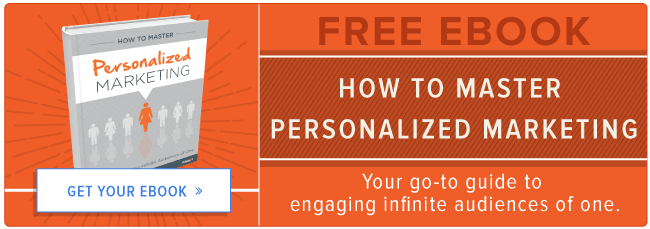
Most marketers know the importance of creating unique content for different social mediums. For instance, would you use the same exact copy in a paid search ad that you did in a tweet? I hope I’m hearing a resounding, “No!”
And yet, many marketers aren’t fully prepared for what comes next: when a visitor actually clicks on a link and lands on their website. If a visitor comes from a paid ad promising a coupon — and then they don’t see the coupon as soon as they arrive on your website, how do you think they’re going to feel? Confused; maybe even frustrated.
But according to a Jackson Marketing Group study, less than 10% of B2B companies are using personalized website content. The companies that do use personalized content are benefitting. In fact, according to an E-consultancy/Monetate report, companies that personalize their website see an average of a 19% increase in sales.
Sound compelling? To help you get started, here are a few simple methods to personalizing content by referral source that your customers will love.
Personalize Content for Social Media Campaigns
Visitors who come to your webpage from social media have different motives and interests than those coming from email marketing or paid campaigns. Why not cater to these specific motives and interests?
For instance, a visitor to your page that got there by clicking a link on Twitter is likely familiar with the Twitter platform and apt to sharing content on Twitter. In this case, Twitter would be that visitor’s last referring social source.
By creating personalized content from a visitor’s last referring social source, you can pinpoint the platform they’d most likely want to share your content on. You can also include textual references to the visitor’s last social media source to cater to their interests.
Below are examples of personalized content made for visitors coming from specific social sources: Facebook and Twitter.
For Facebook Users
With more small businesses on Facebook than ever before — 30 million, according to TechCrunch — the competition for organic reach is becoming fiercer by the day. But by personalizing content for visitors who land on your website from Facebook, you can increase customer activity and involvement on the social platform.
The example below boasts personalized text and social sharing buttons (highlighted in red) specifically for visitors coming from Facebook.

The Facebook sharing icon on this company webpage allows Facebook visitors to immediately share content from their own accounts with one click. There’s also personalized text that clearly mentions Facebook. It’s a win-win situation: The content is customized just for Facebook visitors so they can easily share your content, and it caters to the visitor’s unique social media preference.
For Twitter Users
According to MediaBistro, 67% of Twitter users are far more likely to buy from the brands they follow on Twitter. Go a step beyond simply using Twitter for brand awareness by personalizing content on your webpage for Twitter users, thereby improving their experience with your brand.
Notice how the click-to-tweet button in the example below makes it easy for Twitter users to share your company’s content.

Site visitors who like to use Twitter will be able to quickly tweet out these short, snackable quotes — without ever having to leave your webpage.
Personalize Content for Email Campaigns
Composing a successful email campaign involves coming up with a list of email recipients with specific interests. But why spend so much time carefully selecting email recipients when you’re just going to direct them to a generic webpage anyone has access to? To give them a better user experience, send them to a webpage with content specifically catered to their interests.
Let me give you an example. Let’s say HubSpot creates an email campaign for customers who might like a photo editing feature in their product. In their email to those customers, they include a link directing them to the company’s product page, which contains more information about that feature.
The problem is this: That specific photo-editing feature is not at the top of the page. So when email recipients click through, they see a different feature first — whereas the photo-editing feature they clicked through to see is actually buried below the fold.
But how do you solve this problem? Thankfully, you don’t need to create unique product pages for every email single email list would be extremely time-consuming. Instead, by personalizing by referral email source, you can build onto an existing webpage to highlight a specific part of the page that users from that email source are interested in. When an email recipient clicks the link in that email, they aren’t taken to a generic product page — they’re taken to a customized product page that shows the photo-editing upgrade first so that it’s the first thing users see.
It’s all about personalizing for the individual visitor. Personalize by referring email source so you can pinpoint information — such as an image, video, or GIF — that caters to the visitor’s unique needs as soon as they land on your webpage.
Customize Content for Paid Search Campaigns
If you’re going to devote a portion of your budget to paid search ads, then it’s best to send the people who click on those ads to pages optimized for their conversion. It can be very frustrating for a visitor to read certain text in an ad, such as information about a sale, only to land on your webpage and not find any more details on the matter.
But if you personalize content for visitors coming from a specific paid search campaign, you can highlight key information included on the ad right onto an existing webpage to drive more conversions and improve overall user experience.
Take a look at the example below. This dress company is running a marketing campaign for its new dress line. As part of the campaign, the company created a series of Google paid search ads that feature an exclusive discount code, highlighted in red below. Originally, the company’s paid search ad linked to the new line’s generic product page that all visitors could see (highlighted in black in the image below).

Although this product page includes the summer dresses mentioned in the ad, the discount code is missing. The visitor may become frustrated and confused when the promised 50% off discount — a major driving factor in why the visitor to click on the ad in the first place — isn’t displayed right away.
Creating a unique webpage that highlights information from each individual paid search ad (such as a discount code) would be an incredibly time-consuming process. But, by using a smart content tool like HubSpot’s, you can personalize content for all paid search ads in the same campaign to make it easier for customers to find the information that they are looking for.
The image below shows the same dress company’s personalized content, created just for visitors coming to their website from their paid search campaign. Notice the banner containing the discount code information at the top of the page.

Personalized content by ad search campaigns will help visitors to find the information they are looking for while also increasing the number of conversions and satisfied customers on your website.
What methods has your company used to personalize content by source to enhance user experience on your website?
![]()


